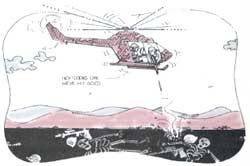Radar hunt
 RESEARCHERS in the US have developed an easy, risk-free method to find buried landmines. All you have to do, they say, is fire a special bullet into the ground from a helicopter and the bullet will do the rest. The 'special' bullet emits a radar pulse as it grinds to a halt, thus providing an effortless way to find not only landmines but minerals, oil and various other buried natural resources.
RESEARCHERS in the US have developed an easy, risk-free method to find buried landmines. All you have to do, they say, is fire a special bullet into the ground from a helicopter and the bullet will do the rest. The 'special' bullet emits a radar pulse as it grinds to a halt, thus providing an effortless way to find not only landmines but minerals, oil and various other buried natural resources.
Ground-penetrating radar is potentially one of the most accurate ways of locating landmines. A radar emits pulses of radio waves into the ground, and their reflections are analysed by a computer. But little radiation actually penetrates the soil - most is reflected back by the ground because of the sudden disparity in the density between the air and the soil. This implies that such ground radar systems need large power supply to generate waves or pulses strong enough to penetrate the ground. This makes these systems bulky - a major drawback in mine detection as most of the minefields are located in remote corners of the world.
To bypass these obstacles, electrical engineers Thomas Engel and William Normally from the University of Missouri in Columbia, USA, with us $5 million in funding from the us army, designed a bullet that emits a powerful burst of radio waves once it is under the ground. The duo's final aim is to design a radar bullet that can be fired straight down from a helicopter hovering some 100 metres (in) above the ground. The bullet will produce a pulse of radio waves as it pierces the ground, and the reflections from any landmine within a 15-m radius will be detected by an antennae mounted on the helicopter hovering overhead. "You do not have to be on the ground - stepping on mines - to use it," says Engel. Once the mines have been located, they can either be destroyed or have their positions marked accurately so they can be eliminated later. Of course, in case the bullet hit a mine itself, it would explode.
The radar pulse is generated from the bullet's kinetic energy by a process known as magnetic flux compression. Inside Engel and Normally's radar bullet is a metal cylinder, surrounded by a tightly-wound coil of wire. As the bullet leaves the gun, a battery passes a current through the coil, thus generating a magnetic field in the cylinder. When the bullet smashes into the ground, the abrupt deceleration forces the cylinder out of the coil. This sudden movement of the metal cylinder through the magnetic field induces a large pulse of current in the coil. The coil then acts like an antenna, converting the pulse into a short burst of high-frequency radiation.
The light-weight system is portable, and can be easily fitted to any helicopter. In tests conducted so far, Engel has found their 30-millimetre bullet emits a four kilowatt radar pulse - much more powerful than any other ground penetrating radar - from 20 centimetres down.
